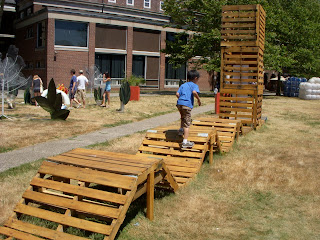On view July 2-August 6, 2010
Katherine Gressel, Curator
In this
Pallet City exhibit, six artists/artist teams respond to the idea of a shipping pallet gallery by exhibiting work made with found or recycled materials. These artists also address questions of the Ideal City as related to the history and future of Governors Island, having mined the island for both building materials and subject matter for their work.
Marina Zamalin’s photo dioramas juxtapose images of Governor’s island and other sites that suggest different possible solutions for the island’s future. Deborah K. Hall re-purposes a found wood cabinet and found sheet metal as a metaphor for “Governors Island as a more carefree world”—the cabinet’s door opens to reveal images of play. Julia Whitney Barnes and Triada Samaras/Susan Handler Konvit address the importance of preserving the island’s natural landscape, from the East River that has become “scarred” by chemicals, to disappearing local wildlife-- Whitney Barnes sees the island as “a perfect location for a bat refuge because of its abundance of abandoned buildings and ample tree cover.” For Katherine Gressel, wood scraps found on the island become canvases for small plein-air paintings completed in one afternoon at Pallet City—they reveal new vantage points of the island as seen through pallet walls. Michael Sherman also explores the potential of the pallet not just as a support structure, but a means of fracturing space and encouraging new interactions with the island.

Marina Zamalin,
Island Dioramas 1 and 2, 2010, Photo collage, mixed media




Katherine Gressel,
Pallet City Plein-Air, 2010, Acrylic on found wood





Triada Samaras and Susan Handler Konvit,
Scarring Our Water, 2010, Canvas, acrylic paint, bamboo, human hair, grommets, wood burning, epoxy, polyurethane


Deborah K. Hall,
Go out and Play, 2010, Found wood cabinet, acrylic paint, oil paint, found sheet metal, wire





Michael Sherman,
Every Other One (Propeller), 2010, Stain and paint on found pallet wood


Julia Whitney Barnes,
Gilded Phytophilic Bats, 2008, Stoneware, glaze, gold luster, brass wire





Visitor-drawn graffiti from our first, participatory exhibit: we sanded some of it off, but kept the contributions we liked the most that were written in response to the question: "What is your idea of the ideal city?"














 From Kseniya: "Art"
From Kseniya: "Art"
 From Karina: Eli, Age 7
From Karina: Eli, Age 7
 Marina Zamalin, Island Dioramas 1 and 2, 2010, Photo collage, mixed media
Marina Zamalin, Island Dioramas 1 and 2, 2010, Photo collage, mixed media


 Katherine Gressel, Pallet City Plein-Air, 2010, Acrylic on found wood
Katherine Gressel, Pallet City Plein-Air, 2010, Acrylic on found wood



 Triada Samaras and Susan Handler Konvit, Scarring Our Water, 2010, Canvas, acrylic paint, bamboo, human hair, grommets, wood burning, epoxy, polyurethane
Triada Samaras and Susan Handler Konvit, Scarring Our Water, 2010, Canvas, acrylic paint, bamboo, human hair, grommets, wood burning, epoxy, polyurethane
 Deborah K. Hall, Go out and Play, 2010, Found wood cabinet, acrylic paint, oil paint, found sheet metal, wire
Deborah K. Hall, Go out and Play, 2010, Found wood cabinet, acrylic paint, oil paint, found sheet metal, wire



 Michael Sherman, Every Other One (Propeller), 2010, Stain and paint on found pallet wood
Michael Sherman, Every Other One (Propeller), 2010, Stain and paint on found pallet wood
 Julia Whitney Barnes, Gilded Phytophilic Bats, 2008, Stoneware, glaze, gold luster, brass wire
Julia Whitney Barnes, Gilded Phytophilic Bats, 2008, Stoneware, glaze, gold luster, brass wire
























 =
=












 Our friends love to "learn!"
Our friends love to "learn!"

